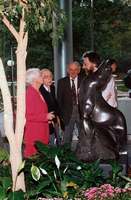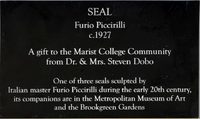Statue of the Seal
Dr Stephen (1901 - 1998) Dobo, a psychiatrist at Hudson River State Hospital and his wife Estelle Effron (1908 - 2003) lived at 7 Dwight Street. In 1916 the house was sold by M. Florence Sterling to Ada Thurston and Jennie B Thurston (1916 liber 393 page 575). When Ada Thurston died, she willed the house to Vassar College (1944 liber 619 page 58). Vassar College sold it in 1944 to the Dobos (1944 liber 622 page 215). Richard Foy was a guest of the Dobos on several occasions. The Dobos donated an unusual piece of sculpture to Marist College; it is on permanent display in the Dobo Sculpture Garden, Donnelly Hall Atrium. After Estelle died, a memorial service honoring both Steven and Estelle was held at the Atrium. The house at 7 Dwight street has been razed and the land is now attached to 3 Dwight street house.
This statue is a gift of Dr. Stephen Dobo and his wife Estelle (nee Effron) who were friends of Marist College.
In the 1970s, then President Linus Richard Foy, visited the Dobo's on several occasions at their house on Dwight Street. After Foy left Marist in 1979, the relationship was continued by others at the college
The only other known copies of this sculpture by Furio Piccirilli are at the Metropolitan Museum of Art in New York City and Brookgreen Gardens, Myrtle Beach SC.
Seal
A seal is balanced at the top of a rock, the head lifted and the lithe body bent backward in a series of flowing curves. The hind flippers cling to the rock while the front flippers brace the body. In the modeling are preserved all the elasticity and fluid motion of the creature. The example in the Metropolitan Museum is dated 1927. This statue was awarded the Speyer Prize at the National Academy of Design exhibition in 1929. (Excerpt from Brookgreen Gardens catalog)
Brookgreen Gardens, the first public sculpture garden in America, has in its collection more than 1,400 works by over 350 sculptors. Exhibited within the gardens is the largest and most comprehensive collection of American figurative sculpture in the country, by sculptors who worked from the early nineteenth century to the present. Brookgreen Gardens is a National Historical Landmark, and is accredited by the American Association of Museums. Brookgreen offers workshops in sculpture by nationally known sculptors throughout the year.
Furio Piccirilli
Furio Piccirilli was born at Massa, Italy, on March 14th, 1868. He came to the United Stales with his parents in 1888. Educated at the Accademia di San Luca, Rome, like his brother Attilio, he shared responsibility for the figure sculpture in the family's many commissions. Attilio, in listing the special abilities of each of his brothers, described Furio as a "bas-relief sculptor." He has been considered the most creative and the best modeler of them all. his work won honorable mention at the Buffalo and silver medals at the Saint Louis and Panama-Pacific expositions. His chief contribution at San Francisco was four ably composed groups of many figures for the Court of the Seasons.
In 1920 he designed the sculptural decoration of the Parliament House winnipeg, Canada. it included a seated statue of Pierre Gaultier de Varennes in which pictorial use was made of the elaborate eighteenth-century costume. A statue of Murillo, a long cloak giving stability to the figure, was sculptured for the Fine Arts Gallery San Diego. Conceived in a modified Renaissance style, with delicate low relief, is a Madonna, and a merry Baby Faun has the sensitiveness of a Florentine fifteenth-century work. Saint Cecilia is in Saint Agnes's Church in New York. He also made a number of animal studies. In 1921 Furio went to Rome and married a cousin while there. After a few years he came back to New York and planned to remain permanently. Hoping that the climate would be better for his son's health, he returned to Rome in 1926 and stayed there until his death in 1949. He was a member of the National Academy of design and an associate of The architectural League of New York.
Streetscapes / The Piccirillis
New York Times, Sunday 17 October 1999
Six Brothers Who Left Their Mark as Sculptors
At their Bronx studio, Lincoln of the Lincoln Memorial was carved.
By CHRISTOPHER GRAY
The colossal figure of Abraham Lincoln what broods in Washington's Lincoln Memorial was carved at what is now a vacant lot in the Bronx, one of the works of the Italian-born Attilio Piccirilli and his five brothers, who left their mark asa sculptors all over America, and especially in New York.
Next Sunday, as part of an exhibition on Italian Americans at the New york Historical Society, William Carroll and Mary Shelley will give a lecture on the family's contribution to American Culture.
Works like the figure of Lincoln were carved in the brothers' studio complex on East 142nd Street in the Mott Haven section of the Bronx, now a vacant lot. Mr. Carroll ( who was brought up in the neighborhood) and Ms. Shelley hope to have the street renamed for the sculptors and have a nearby play area rebuilt as a memorial.
Attilio Piccirilli (pronounced peach-er-EEL-y) was born in 1866 near the marble center of Carrara, in Tuscany. In 1887, his father, Guiseppe, immigrated to the United States, taking Attilio and his five brothers - Ferrucio, Furio, Getulio, Masaniello, arid Orazio - to New York. All the brothers had been trained as sculptors (Attilio had been a star pupil) and by 1893 they built a peculiar studio and row house combination on 142d Street, between Willis and Brook Avenues.
The firm had ups and downs until 1901, when Attllio Piccirilli beat out 40 other entrants in the the competition for the sculpture portion of the Maine Monument at Columbus, Circle, a commission that gave him and the firm national visibility. A short time later he had the architect for the monument, H. Van Buren Magonigle, design a large new studio adjacent to the older buildings in their complex on East 142d Street; the brothers decorated the plain brick facade with reliefs and medallions.
From this cluster, which grew to four buildings, came some of the most distinguished architectural sculpture in New York, most designed by other artists and executed by the Piccirillis. They, included the pediment group at the New York Stock Exchange (1904); the "Four Continents" in front of the United states Custom House at Bowling Green (1907); the lions and cornice sculpture at the New York Public Library and the controversial "Civic Virtue," placed in City Hall Park in 1922 but later removed to Queens Boulevard at Union Turnpike.
When the sculptor Daniel Chester French was approached to do more than $100,000 worth of facade sculpture for the Brooklyn Museum, he said he was uninterested unless he could use his favorite carvers. This meant that the Piccirillis got the job, which included 30 giant statues at the cornice line, for which they were paid $1,500 each.
French arranged forAttilio to design two of the sculptures, the allegorical figures of "Indian Literature" and "Indian lawgiver," completed in 1913. Attilio also designed the Firemen's Memorial at l00th Street and Riverside Drive, completed in 1913.
The Piccirillis carved the Lincoln Memorial's 19-foot high figure of Abraham Lincoln out of 24 blocks of Georgia marble from French's seven-foot high plaster model, completed in 1922. In 1924 court papers in a divorce suit brought by Attilio's wife, Julia, stated that the firm's gross income in 1923 was $84,213.
Dixie Willson, writing in The American Magazine in 1930 depicted the studio as a place of laughter and camaraderie. She quoted Attilio as breathlessly running into the studio shouting, "Furio! Getulio! Maso! We have won a prize. In the exhibition at the National Academy of Design, the gold medal is given to Furio!" She marveled that the brothers considered Furio's medal as an honor shared by all.
Other accounts indicate that Attilio cooked lunches for the entire workshop, mounds of spaghetti with tomato sauce and Romano cheese.
Fiorello H. LaGuardia was a personal friend, and in 1944 wrote the foreword in Attilio's biography, "Attilio Piccirilli, Life of an American Sculptor..." by Josef V Lombardo: "To see him on the street, in the home, in the subway, you would never recognize him as one of the outstanding sculptors of our time. He dresses like a businessman, no long flowing black tie. His clothes fit him and he is the most modest man that ever lived ... I have never heard him knock a fellow artist. I taught him how to laugh 35 years ago. We have been laughing ever since."
Mr. Carroll says that LaGuardia's nickname for Attilio was "Uncle Peach." In 1921, Attilio designed the funeral monument for LaGuardia's wife, Thea, and 1-year-old daughter, Fioretta, who died a few months apart.
After the teen years of the 20th century extensive figural sculpture became less important. In 1930 Attilio wrote The New york Times that he avoided going past the Maine and Firemen's monuments "for fear of what my eyes might encounter in the form of neglect and gross desecration." His unusual glass relief sculpture at the entrance to Rockefeller Center's Palazzo d"Italia was one of a dwindling number of commissions.
Gennaro Capacchione, who lives in the Flushing section of Queens, says he visited the brothers frequently in the 1930's and 1940's. "They were a bit upset" at the modern movement, he recalls, especially when "an art critic suggested that the bronze sculptures on top of the Maine Monument be melted down for the war effort."
Attilio Piccirilli died in 1945 at the 142d Street studio, three days after his brother. "Sculpture had changed," says Mr. Carroll, a math teacher at the Riverdale Country School. "Even if they had a couple of decades left, they would have had a hard time." He believes the studio was demolished sometime around 1960.
A few years ago a friend remarked to Mr. Carroll and Ms. Shelley, his wife, that the Lincoln statue in Washington had been carved just a few blocks from where Mr. Carroll grew up on East 135th street. "It surprised me that I had never heard a thing about it," Mr. Carroll says, and he and his wife have since written and lectured about the Piccirillis.
Both Mr. Carroll and Ms. Shelley still have questions about the firm, such as how the office records and possessions seem to have vanished.
Marist College | Marist Archives & Special Collections | Contact Us | Acknowledgements





